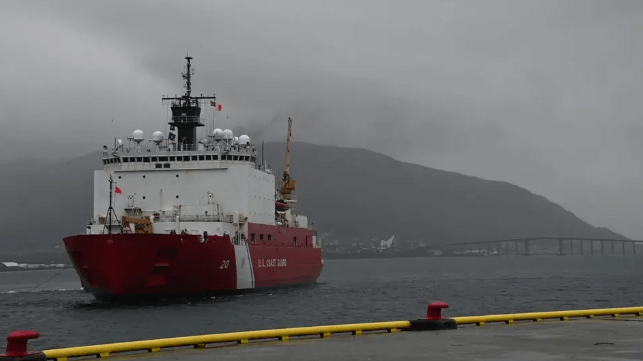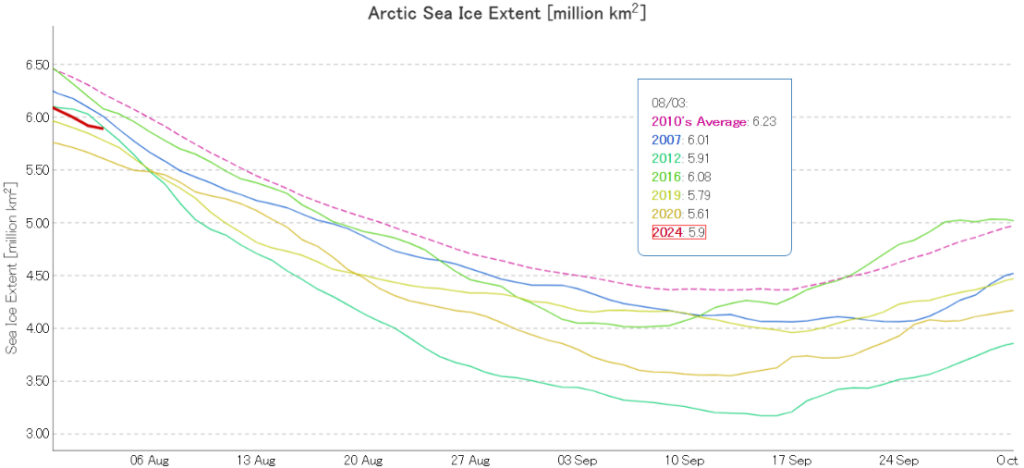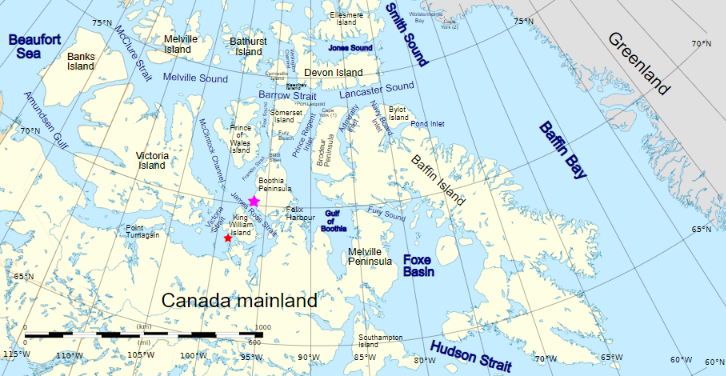Following the invasion of Ukraine, the region is reproducing deep divisions between Russia and the West in lower latitudes.

While climatic tipping points have received significant attention from scientists, geopolitical tipping points in the Arctic are little examined. Yet that is exactly what the war in Ukraine has proven to be.
The Arctic has long been a canary in the coal mine for global climate change, foreshadowing for the rest of the planet what warmer and wetter future awaits. Yet when it comes to geopolitics, since the end of the Cold War, the region has been perceived as existing on a separate timeline. The Arctic has enjoyed a reputation for being immune to enmity elsewhere and for successfully encouraged its eight constituent territorially sovereign states – the U.S., Canada, Denmark, Iceland, Norway, Sweden, Finland, and Russia – to cooperate rather than come to blows.
This idea of “Arctic exceptionalism,” was first defined and, notably, critiqued by Gail Osherenko and Oran R. Young in their book, The Age of the Arctic, published in 1992. At the same time, in the early 1990s as the Soviet Union seemed to be opening up (but before it collapsed), Arctic exceptionalism was taking root in policy circles. Analysts and government officials from Arctic states championed the belief that the uniquely icy and remote Arctic could foster dialogue across borders. Chief among these proponents were the Finnish and Canadian governments. They both took inspiration from Gorbachev’s famous speech delivered in 1986 in the Russian city of Murmansk, the world’s largest Arctic city, calling for the region to be a “zone of peace.”
Representatives from Finland, a country eager to build ties with other Arctic states, consulted their Arctic counterparts about constructive methods for cooperation. The Finns determined that the environment would be the most likely issue to foster cross-border ties.
Radioactive circumpolar diplomacy
Finland’s finding that nature could serve as a vehicle for circumpolar diplomacy aligned with its existing goals of combatting environmental issues. The country had firsthand knowledge of the destructive impacts of transboundary pollutants following the Chernobyl disaster in 1986. The plume from the nuclear catastrophe contaminated reindeer pastures across Fennoscandia. Later studies would reveal that even prior to Chernobyl, in the 1950s and 1960s, reindeer herders across the Arctic had some of the highest levels of exposure in the world to the fallout from nuclear weapons testing due to how radionucleotides progress up the lichen-reindeer-human food chain.
Much as climate change has galvanized international cooperation in the 21st century, concerns about radioactivity in the 1980s and 1990s motivated countries to come together. In some sense, Chernobyl and Gorbachev’s speech were two tipping points that balanced the Arctic scales in favor of cooperation.
From the Arctic Environmental Protection Strategy to the Arctic Council
In Rovaniemi, Finland in June 1991, the Arctic’s eight states adopted the Declaration on the Protection of the Environment, which birthed the Arctic Environmental Protection Strategy (AEPS). Six months later, the Soviet Union would collapse – yet Arctic cooperation would continue. AEPS studied and tackled transboundary issues such as pollution from oil, radioactivity, persistent organic pollutants (POPs), and heavy metals. Managing transboundary pollution became more urgent once the full scale of environmental degradation in the Russian Arctic – a homeland for people ranging from the reindeer-herding Nenets to the walrus-hunting Chukchi – became clearer following the Soviet collapse.
The AEP laid a firm foundation for regional cooperation and, promisingly, a brighter and more cohesive Arctic. In 1996, with five years of multilateral governance addressing environmental issues under their belt, the eight Arctic states were ready to come together to form the Arctic Council. The intergovernmental organization also created formal roles for Indigenous Peoples’ organizations. As Permanent Participants, they must be consulted on all decisions.
The Kiruna Ministerial: A high point – and end point – for Arctic exceptionalism
Over the next two decades, as global political, economic, and scientific interest in the Arctic grew, the Arctic Council continued to strengthen. In 2011, the first legally binding agreement under the auspices of the Arctic Council was signed on aeronautical and maritime search and rescue. In 2013, a second agreement was reached on marine oil pollution preparedness and response. That same year, a watershed moment also came for the Arctic Council to demonstrate its progressiveness and inclusivity. At the biennial Arctic Council ministerial meeting held in Kiruna, Sweden that year, the Asian states of China, Japan, South Korea, India, and Singapore were admitted as observers, along with Italy and, conditionally, the European Union.
Some analysts thought that this significant expansion of the Arctic Council marked a tipping point that would usher in a new global Arctic. Arctic exceptionalism, too, arguably reached a high point in 2013. What other part of the world, so the thinking went, could bring together parties as disparate as the U.S., China, Russia, and Indigenous Peoples?
Russia annexes Crimea, pivots east, and invades Ukraine
Less than a year later in March 2014, severe cracks began to show when Russia annexed Crimea. While Arctic cooperation continued under the auspices of the Arctic Council, U.S. and European Union sanctions limiting trade in the defense and energy sectors began to push Russia to turn to China. The country’s “Pivot to the East” came as the Asian giant was seeking to expand its Belt and Road Initiative launched in 2013 – a multi-trillion-dollar plan to improve global trade and transportation infrastructure.
Although illusions of Arctic exceptionalism persisted even after Crimea’s annexation, Russia’s illegal invasion of Ukraine on February 24, 2022 put them to rest. The war has not only potentially killed tens of thousands of people in Ukraine and caused millions more to flee their homes. As a serious geopolitical tipping point, it has generated knock-on effects that have spread all the way to the very latitudes that Gorbachev envisioned as a “zone of peace.”
The invasion of Ukraine marked a catastrophic moment for the Arctic. The conflict has pushed the region into a qualitatively different state characterized by increased militarization and severely strained governance. Within weeks of the invasion, the Arctic Council “paused” cooperation. Yet offering a small ray of hope for renewed circumpolar diplomacy, in August 2023, all eight member states and the six Permanent Participants agreed to guidelines to allow the body’s six working groups, which tackle issues relating to the environment, sustainable development, and search and rescue to resume. Nevertheless, fully resuscitating regional governance remains a serious challenge.
Militarization stalks the Arctic
Even before Russian President Vladimir Putin set his eyes on Ukraine, the Arctic had been steaming towards a state of higher tension. Russia had been modernizing its Arctic military forces since 2007, when the country resumed air and naval patrols in the region and planted a flag underneath the North Pole. Between 2014 and 2022, Russia has built an estimated 475 new structures across its Arctic zone, including airstrips, bunkers, and bases.
Perspectives on Russia’s continued Arctic militarization are conflicting. Some state that some of these forces have been withdrawn for combat in Ukraine, only to be withdrawn, while others note that Russia’s Arctic military modernization marches on. Reports that Gazprom, one of Russia (and the world’s) largest natural gas producers, and its oil-producing subsidiary, Gazprom Neft, have formed three private military companies, which send their employees alongside other recruits to fight in Ukraine, further complicate the picture. Blurring the line between extraction and invasion, Russian Arctic resource development now appears directly tied to the country’s bloody front lines.
Western forces have stepped up their northern power projection, too. In summer 2023, Finland hosted Arctic Challenge (ACE) 23, a military exercise which has been taking place biennially since 2013. ACE 23 represents Finland’s first NATO exercise since joining the alliance in April 2023. The country’s newfound membership has underscored the Arctic’s importance to NATO, whose border with Russia is now 1,340-km (830 miles) longer. A third of Finnish territory lies north of the Arctic Circle, too, warranting increased attention on the region from the alliance.
Two months after ACE 23, on the other side of Eurasia in the North Pacific, Russia and China carried out a joint naval drill. The two countries sent a flotilla of 11 ships to sail off the Aleutian Islands in Alaska as part of a show of force. In response, the U.S. Navy dispatched four warships to the Aleutian Islands, even as it declared that the Chinese-Russian patrol, which remained in international waters, was “not considered a threat.”
The weaponization of Arctic science
Perhaps more jarring than these northern wargames are the creeping incursions of militaries into scientific endeavors. In August 2023, U.S. Coast Guard Cutter Healy, the country’s most advanced icebreaker, set sail from Kodiak, Alaska for Tromsø, Norway on its five-month Arctic summer patrol. The Coast Guard claims the voyage’s objective is Arctic research. During its journey, Healy is recovering and replacing nine long-term subsurface mooring arrays stretching from the Eurasian Basin to the East Siberian Sea. As a state vessel, under the United Nations Convention on the Law of the Sea, the ship is permitted to transit the Northern Sea Route, which Russia claims as internal waters, without permission.
Nevertheless, Moscow perceives Healy’s voyage as an affront. On September 1, Russia’s research and survey vessel Akademik Nemchinov suddenly began sailing towards Healy, allegedly to keep an eye on it. Then, days after Healy reached the Chukchi Sea, the Russian Pacific Fleet began Finval 2023. The naval exercise was aimed at protecting the Northern Sea Route and Russia’s northeastern borders involved 10,000 personnel and 50 pieces of combat equipment. Vulcan, Granit and Onyx cruise missiles were fired from land, naval ships, and submarines at simulated enemy vessels in the Bering Sea, with one small warship totally destroying a mock enemy ship 300 kilometers away.
Healy continued on its course unharmed, reaching a misty Tromsø for a four-day port of call last week, during which U.S. and Norwegian coast guards practiced search and rescue drills together. But Gorbachev’s aspirations for turning the Arctic into a pacific sea have sunk into its watery depths.
Arctic exceptionalism is no longer, for the region is now reproducing deep divisions between Russia and the West in lower latitudes. Yet while these lines are being drawn, others are being blurred. Russian hydrocarbon extraction appears inseparable from the Russian war machine. Meanwhile, Arctic research vessels are doing double duty as patrol ships. As these new and confused horizons dawn, the Arctic may offer exceptional insights into a future world in which civilian, military, and scientific activities are indistinguishable. In this new zone of contention, everything is a target.





Your point of view caught my eye and was very interesting. Thanks!
Your article helped me a lot, hope here is more related content. Thanks!